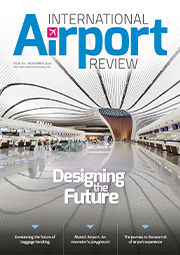Air transport is critical to the world’s recovery from COVID-19
- Like
- Digg
- Del
- Tumblr
- VKontakte
- Buffer
- Love This
- Odnoklassniki
- Meneame
- Blogger
- Amazon
- Yahoo Mail
- Gmail
- AOL
- Newsvine
- HackerNews
- Evernote
- MySpace
- Mail.ru
- Viadeo
- Line
- Comments
- Yummly
- SMS
- Viber
- Telegram
- Subscribe
- Skype
- Facebook Messenger
- Kakao
- LiveJournal
- Yammer
- Edgar
- Fintel
- Mix
- Instapaper
- Copy Link
Posted: 23 April 2021 | Alexandre de Juniac | No comments yet
Alexandre de Juniac, Director General and CEO of IATA, looks back over the devastation of the COVID-19 crisis, but believes that the industry is poised to make a strong come back in the next 12 months.


On 25 January 2020, the International Air Transport Association (IATA), which it has been my privilege to have led over the past four and a half years, issued our first news release about a “coronavirus outbreak” in Wuhan. In a brief statement we noted that we were closely monitoring developments and pointed out that the industry, working with the World Health Organization (WHO) and the International Civil Aviation Organization (ICAO), had well-developed standards and best practices for dealing with such events.
I certainly did not expect that 14 months later, we would still be issuing press statements on the subject, nor that it would erupt into a global tragedy that has taken some 2.7 million lives, left millions more grieving the loss of family and friends, and dealt a devastating blow to many national economies.
Aviation did not escape the carnage. What has happened during the pandemic has been nothing less than catastrophic. Our standards and best practices for safe operations meant little to governments that focused on slowing the spread of the virus by closing borders. The scale of the damage completely eclipsed what happened in 9/11, SARS and the global financial crisis…combined.
In terms of passenger demand, we are back to 1998 levels – a 66 per cent fall from pre-crisis levels. And in terms of passenger revenue, we ended 2020 at 1993 levels. We estimate industry losses last year topped $118 billion and more than one million jobs went away.
With borders closing and demand withering, our global village de-connected. Before the crisis we had almost 30,000 unique international routes between airports. Now we have about 12,000. And the density of those connections is much thinner. Pre‑pandemic, the average route was served by about 43 flights per month. Now it is around 20 – fewer than once daily. The massive loss of connectivity depressed economies worldwide, essentially shutting down international tourism, conventions, exhibitions and the like, along with flying.
Cargo was a lifeline, as demand for personal protective equipment and pharmaceuticals soared. Our industry is nothing if not resourceful, and it did not take long for airlines to start using parked passenger jets to meet demand, in some cases quickly (and safely) reconfiguring them to carry additional cargo on the main decks. By January of this year, cargo had returned to pre-pandemic levels and, of course, aviation is playing a critical role in delivering vaccines.
By itself, however, cargo was not enough to stave off financial disaster, governments had to step in, helping keep aviation aloft with some $225 billion in direct cash infusions, tax relief and loan guarantees. It was a smart investment because a viable air transport sector will be critical to energising the recovery.
The industry has done its homework to prepare for the restart of operations, including ensuring that air travel does not become a meaningful vector for the importation of COVID-19. A recent poll of people who have travelled since June last year shows that 90 per cent believe that the airlines have done a good job in enforcing health safety rules. And 86 per cent reported that the COVID-19 measures made them feel safe on board. That confidence translates into a desire to resume travel. The same poll showed that about 57 per cent of travellers will be ready to fly within a few months of the pandemic being contained.
In short, there is light at the end of the very long tunnel. More and more people are being vaccinated. However, while we believe that vaccines will play an important role in opening borders, they are not a silver bullet. So, testing will also play a role. That will ensure that those who cannot be, or prefer not to be vaccinated, will have an opportunity to travel. And when they do travel – with vaccination certificates or testing results – the IATA Travel Pass will ensure that the industry and governments are ready to handle the documentation efficiently using modern digital processes. In March, Singapore Airlines conducted the first successful pilot of the IATA Travel Pass and similar pilots are underway with other airlines. These trials are a major milestone on the way to the app’s release in April.
But a few issues still need to be resolved to get the industry restarted.
- The first is replacing quarantine with testing/vaccinations. So long as governments maintain quarantine requirements, there will be no restart. With ample capacity, testing to travel is the first option to replace quarantine requirements, and with more and more people being vaccinated, there is a growing population that should be able to travel without restriction.
- Additionally, we require secure digital standards for testing and vaccination certificates. We moved a step closer to this with the latest ICAO Council recommendations announced this month. This should encourage governments to accept digital certificates. But we still need the global standards being worked on by the WHO and Organisation for Economic Co-operation and Development (OECD). With millions of vaccines already being distributed and the EU committed to its Green Pass, you could say this already is late in coming.
- Governments also need to stay engaged. That means continued financial relief measures – particularly those that do not increase the debt burden. That includes cost reduction and, eventually, stimulus measures when people can start travelling again. Already we have seen some creative market stimulation solutions for domestic markets in Japan and Australia. Considering similar measures when restarting international travel can only help.
- We will also need planning. We cannot restart aviation with the flip of a switch. Careful coordination is required to bring thousands of aircraft out of storage, to ensure crew qualifications, to recall laid off employees, to reopen closed terminals and so on. Aviation can only be ready to energise the recovery from day one if governments have a plan and share it with us, as has been done in the UK.
Getting aviation up and running is vitally important. Aviation is the business of freedom, and for over a year COVID-19 has deprived people of that freedom. At the end of this month, I will leave IATA. So, I will be watching the recovery from a different perspective. But I am confident that I am not being over-optimistic when I say that 12 months from now, I expect that aviation’s biggest challenge will be meeting the demand to travel from a world that desperately wants to reconnect.


The rest of this content is restricted - login or subscribe free to access


Why subscribe? Join our growing community of thousands of industry professionals and gain access to:
- bi-monthly issues in print and/or digital format
- case studies, whitepapers, webinars and industry-leading content
- breaking news and features
- our extensive online archive of thousands of articles and years of past issues
- ...And it's all free!
Click here to Subscribe today Login here
Issue
Related topics
Aeronautical revenue, Air freight and cargo, COVID-19, Passenger experience and seamless travel, Passenger volumes


















